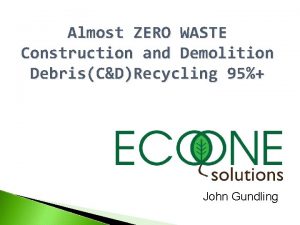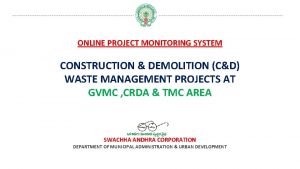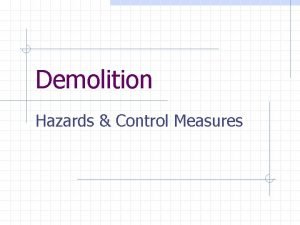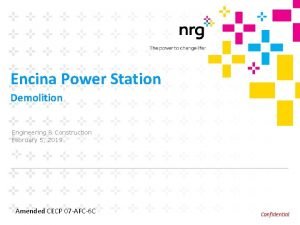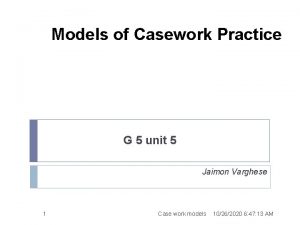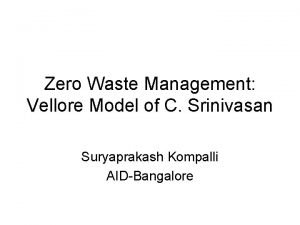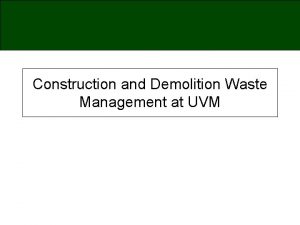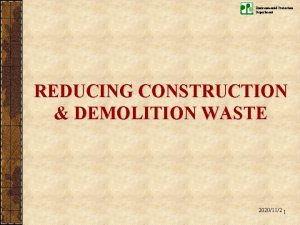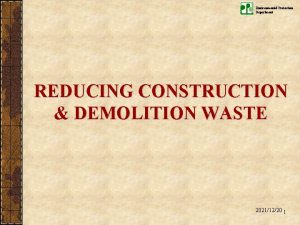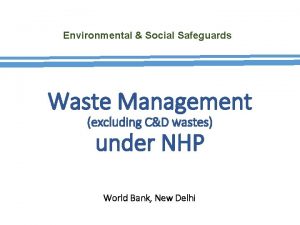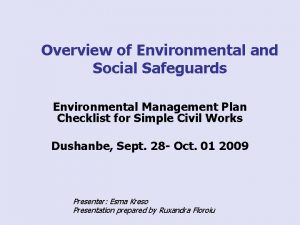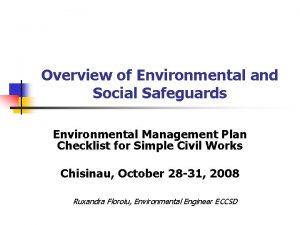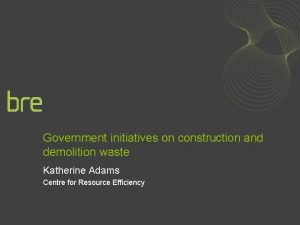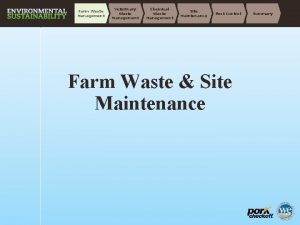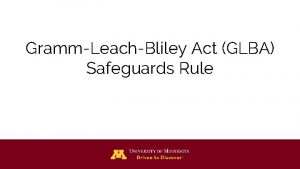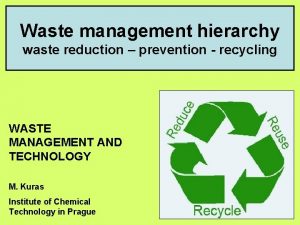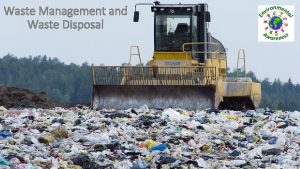Environmental Social Safeguards Construction Demolition Waste Management under























- Slides: 23

Environmental & Social Safeguards Construction & Demolition Waste Management under NHP World Bank, New Delhi

Topics Ø Act, Rules & Guidelines Ø Quantum & Composition Ø Waste management • Asbestos • Hazardous waste C&D Waste dumping on roadside

Acts, Rules & Guidelines ACT: Legislative proposals when passed by both houses of Parliament and assented to by the President become an Act of Parliament. Similar procedure is followed by the State Governments (for subjects mentioned in State and Concurrent Lists) RULES: Rules help govern a law or Act passed by the Legislature. They provide the details that have not been provided for in the Act. GUIDELINES: refer to the principle that provide direction to action or behaviour in following rules and regulations – provide a framework CONSTI TUTION ACT RULES GUIDE LINES

Acts & Notifications related to Environment • The Environment (Protection) Act, 1986 and as amended • Forest Conservation Act, 1980, as amended • Wildlife (Protection) Act, 1972, as amended • Ancient Monuments and Archaeological Sites and Remains Act, 1958 and as amended in 2010 • The Explosives Act 1884 and the Explosives Rules, 2008 • Water (Prevention and Control of Pollution) Act, 1974 as amended • Air (Prevention and Control of Pollution) Act, 1981 as amended • Mines Act, 1952 as amended • Easement Act, 1882 • National Building Codes of India, 2005 and as amended • Environmental Impact Assessment Notification, 2006 • Coastal Regulation Zone Notification, 1991 and as amended

Rules and Guidelines Rules/Guidelines having direct bearing: • Construction and Demolition (C & D) Waste Management Rules, 2016 • Guidelines on Environmental Management of C & D Wastes (Prepared in compliance of Rule 10 sub-rule 1(a) of C & D Waste Management Rules, 2016), 2017 Other Rules having implications on C&D waste management: • Hazardous & Other Wastes (Management and Transboundary Movement) Rules, 2016 • Noise Pollution (Control and Regulation) Rules, 2000, and as amended • Solid Wastes Management Rules, 2016 • E-Waste Management Rules, 2016 • Batteries (Management and handling) Rules, 2001 • Plastic Waste Management Rules, 2016 http: //www. npcindia. gov. in/wp-content/uploads/2017/11/CD-Waste. Management-Tool. Kit-2017_R-1. pdf

C&D Waste management Rules - provisions Construction and Demolition (C&D) Waste Management Rules, 2016 Rule 3 (c): "construction and demolition waste" means waste comprising of building materials, debris and rubble resulting from construction, re-modeling, repair and demolition of any civil structure.

C&D Waste management Rules - provisions Rule 3 (j): “waste generator” means any person or association of persons or institution, residential and commercial establishments including Indian Railways, Airport, Port and Harbour and Defence establishments who undertakes construction of or demolition of any civil structure which generate construction and demolition waste. From: The Hindu, April 04, 2016 From: The Deccan Herald, Feb 14, 2018

C&D Waste management Rules - provisions Duties of the waste generator: Rule 4 (1): responsible for collection, segregation of concrete, soil and others and storage of construction and demolition waste generated. Rule 4 (2): ensure that other waste (such as solid waste) does not get mixed with this waste and is stored and disposed separately. Rule 4 (3): who generate more than 20 tons or more in one day or 300 tons per project in a month shall segregate the waste into four streams such as concrete; soil; steel, wood and plastics; and bricks and mortar and shall submit waste management plan and get appropriate approvals from the local authority before starting construction or demolition or re-modeling work.

C&D Waste management Rules - provisions Duties of the waste generator: Rule 4 (4): keep the construction and demolition waste within the premise or get the waste deposited at collection centre …… there should be no littering or deposition of construction and demolition waste so as to prevent obstruction to the traffic or the public or drains. From: The Times of India, Feb 09, 2019 Rule 4 (5): pay relevant charges for collection, transportation, processing and disposal as notified by the concerned authorities.

C&D Waste management Rules - provisions Duties of the service provider & contractors: Rule 5 (2): shall remove all construction and demolition waste and clean the area every day, if possible, or depending upon the duration of the work, the quantity and type of waste generated, appropriate storage and collection, a reasonable timeframe shall be worked out. Rule 5 (3): In case of the service providers (& their contractors) have no logistics support to carry out the work specified in subrules (1) and (2) , they shall tie up with the authorised agencies for removal of construction and demolition waste and pay the relevant charges

C&D Wastes - Quantum & Composition Quantum of C&D Wastes generation: • Uncertainties in estimating the quantum of C & D waste generation o different methods adopted to estimate quantum o varying pace of developmental activities o C & D waste generation is project specific • Technology Information, Forecasting and Assessment Council's (TIFAC) estimations on C&D waste generation : Ø 40 -60 kg per sq. m of new construction Ø 40 -50 kg per sq. m of building repair Ø 300 -500 kg per sq. m for demolition of buildings. highest waste generation comes from demolition of buildings

C&D Wastes - Quantum & Composition of C&D Wastes: • Waste paints, varnish, solvents, sealers, thinners, resins, roofing, cement, adhesives, machinery lubricants, and caulk • Drums and containers that once contained the items listed above; • Treated wood, including lumber, posts, ties, or decks, and utility poles; • Asbestos-containing items, such as certain older types of floor tile, insulation, or other materials containing asbestos. (Toxic Substances); • Lead-based paint, or lead flashing or solder; • Products containing mercury. Need to follow Rule 4 of C&D Waste Management Rules, 2016 for segregation into 4 categories and separating other wastes.

C&D Wastes - Quantum & Composition • Building Materials and Technology Promotion Council (BMTPC): Demolition of old buildings, major demolition wastes are: o bricks (26%) & masonry (32%), Concretes (28%), metal (6%), wood (3%) others (5%). • Technology Information, Forecasting and Assessment Council (TIFAC), 2001: Typical composition of Indian C & D waste is: Material Composition Soil, Sand & Gravel 36% Brick & Masonary 31% Concrete 23% Metals 5% Bitumen 2% Wood 2% Others 1%

C&D Wastes - Quantum & Composition Hypothetical example: • For demolition of a building of 1000 sq. metre and construction of a new building of the same size, the C&D waste likely to be generated would be: • Demolition waste – 1000 x 400 = 400 tonnes • Construction waste – 1000 x 50 = 50 tonnes Material Composition of C&D Waste (in tonnes) Soil, Sand & Gravel 162 Brick & Masonary 140 Concrete 104 Metals 22 Bitumen 9 Wood 9 Others 4

C&D Waste Management Rules promote waste utilization • Rule (6) under Duties of Local Authority provides for creation of facilities for recycling of C&D wastes • Rule (7) mentions the ‘Criteria for storage, processing or recycling facilities C&D waste and its products’; • Rule (9) sub-rule (4) mentions that the ‘Procurement of materials made from construction and demolition waste shall be made mandatory to a certain percentage (say 10 -20%) in municipal and Government contracts subject to strict quality control’ • Rule (11) under Duties of Bureau of Indian Standards (BIS) and Indian Roads Congress (IRC): ‘The BIS and IRC shall be responsible for preparation of code of practices and standards for use of recycled materials and products of construction and demolition waste.

C&D Waste Management {Contd. ) Type of waste Potential use of C & D wastes Concrete The utilization of recycled aggregate is particularly very promising as 75 per cent of concrete is made of aggregates. Bricks If deconstructed properly, bricks can be reused after removal of mortar. Broken bricks can be used for refilling or for manufacturing debris paver blocks or debris blocks. Stone can be reused for plinth formation, masonry construction, landscape purpose, ledges, platforms, window sills, coping etc. depending upon the form of available stones.

C&D Waste Management {Contd. ) Type of waste Potential use of C & D wastes Timber Opportunity : Whole timber arising from construction and demolition works can be utilized in other construction projects Plywood and other timber based boards Reused for interior works in new construction or it can be recycled for manufacturing of timber based boards. Gypsum Plaster developed from waste gypsum has showed improved engineering properties without any harmful effect. Metals & metal alloys Ferrous Metals are the most profitable and recyclable material. Scrap steel is almost totally recycled and allowed repeated recycling.

C&D Waste Management C&D debris recycling plant, Burari, New Delhi From: The Hindustan Times, March 14, 2019

C&D Waste Management Hierarchy in waste management United Nations Environment Programme (UNEP) • waste management includes both the components of prevention and disposal of waste • Waste management comprises three steps: a. Reduce its production b. Explore its reuse and recycle potential c. Final disposal • C&D Waste management in India also follows the hierarchy of waste disposal, either directly or indirectly.

C&D Waste Management Hazard Waste Management Rules, 2016 (Rule 4) Hierarchy in waste management w. r. t. Responsibilities of the occupier for management of hazardous and other wastes- For the management of hazardous and other wastes, an occupier shall follow the following SIX steps, namely: i. Prevention; ii. Minimization; iii. Reuse, iv. Recycling; v. Recovery, utilization including coprocessing; vi. Safe disposal. Solid Wastes Management Rules, 2016 (Rule 3) “waste hierarchy” means the priority order in which the solid waste should be managed by giving emphasis to prevention, reduction, reuse, recycling, recovery and disposal, with prevention being the most preferred option and the disposal at the landfill being the least;

C&D Waste Management {Contd. )

C&D Waste Management {Contd. )

Thank You
 Demolition zero waste
Demolition zero waste Valid safeguards in antt
Valid safeguards in antt Liberty protection safeguards flowchart
Liberty protection safeguards flowchart Legal safeguards in nursing practice
Legal safeguards in nursing practice Objectivity safeguards in research process.
Objectivity safeguards in research process. Due process safeguards
Due process safeguards Upper merion high school demolition
Upper merion high school demolition Demolition monitoring solutions
Demolition monitoring solutions Cdm demolition
Cdm demolition Modern demolition initiators
Modern demolition initiators Encina power plant demolition
Encina power plant demolition Earthworks recycling
Earthworks recycling Murtagh demolition
Murtagh demolition Description of waste
Description of waste Mh 605
Mh 605 Environmental legislation in construction
Environmental legislation in construction Social thinking and social influence in psychology
Social thinking and social influence in psychology Social thinking social influence social relations
Social thinking social influence social relations Health social and environmental responsibility
Health social and environmental responsibility Campaign with responsibility project
Campaign with responsibility project Supportive and modificatory model by hamilton
Supportive and modificatory model by hamilton Limitations of responsibility accounting ppt
Limitations of responsibility accounting ppt Esj action plan
Esj action plan Vellore srinivasan waste management
Vellore srinivasan waste management
